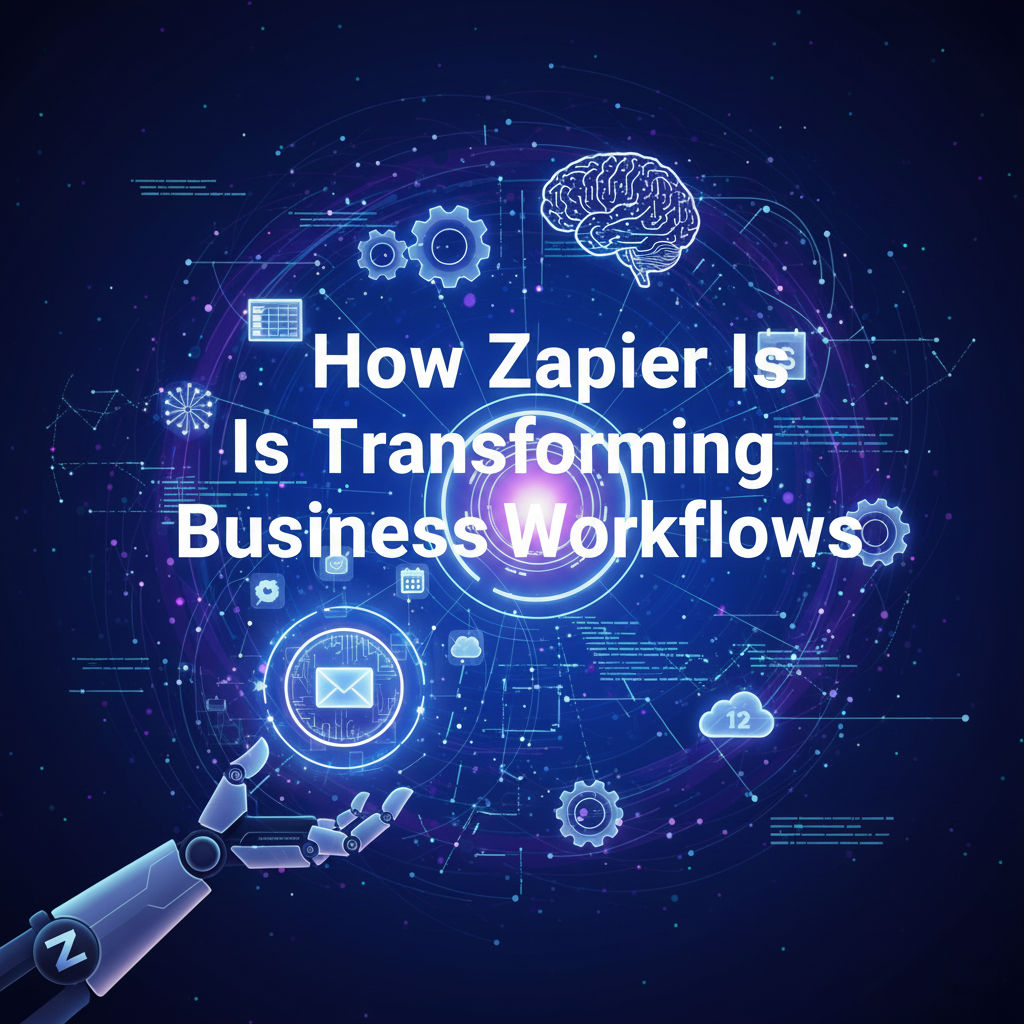In the fast-paced world of digital business, time is the most valuable asset. The average professional spends countless hours every week on repetitive, manual tasks moving data from one app to another, sending follow-up emails, or updating spreadsheets. This constant manual work can be a major drain on productivity and can stifle a business’s growth.
Zapier is a revolutionary platform designed to solve this exact problem. It is a powerful workflow automation tool that acts as the digital glue connecting over 6,000 different apps. By building automated workflows called “Zaps,” you can connect your favorite apps and let them do the work for you, freeing you up to focus on strategy and growth. This comprehensive guide will take a deep dive into what Zapier is, how its AI technology works, its transformative features, and how content creators, marketers, and businesses can leverage its power to automate their workflows and boost their productivity.
What Is Zapier and How Does Its Automation Technology Work?
Zapier is a cloud-based platform that allows you to automate tasks between two or more apps without any coding. At its core, Zapier uses a simple, three-part logic:
- Triggers: An event in one app that starts the Zap.
- Actions: The event that Zapier performs in another app.
- Zaps: The entire automated workflow, from the trigger to the action.
For example, a “Zap” could be: “When I get a new email in Gmail (Trigger), add the sender to a Google Sheet (Action).” Zapier’s AI technology works behind the scenes to make this process seamless and intelligent. It uses advanced machine learning to help you set up Zaps, suggest new automation possibilities, and even handle complex data formatting. This makes the platform incredibly user-friendly and accessible to anyone, regardless of their technical skill.
A Deep Dive into Zapier’s Core AI Features

Zapier is more than just a simple automation tool. It has integrated powerful AI features to make its automation smarter, more versatile, and even more powerful.
1. AI by Zapier: The Universal AI Assistant
AI by Zapier is a powerful feature that allows you to integrate AI into any of your Zaps. You can use it to:
- Generate Text: Automatically create a social media post, an email draft, or a blog post outline based on a trigger.
- Classify Data: Use AI to categorize incoming emails, support tickets, or form submissions.
- Format Data: Ask AI to reformat dates, times, or addresses from one app to another.
This allows you to add a layer of intelligence to your workflows. For example, you can create a Zap that says: “When I get a new email in Gmail (Trigger), use AI to summarize the email (AI Action), and then add the summary to a new row in Google Sheets (Action).”
2. Natural Language Zap Creation
Zapier’s new natural language interface allows you to create Zaps with simple commands. Instead of manually clicking through a complex series of steps, you can just type what you want to do. For example, you can type: “Send me a Slack message when a new task is created in Trello.” The AI will understand your request and build the Zap for you. This makes the platform incredibly intuitive and easy for new users to get started.
3. Paths by Zapier: Intelligent Workflows
Paths are a powerful feature that allows you to create more complex and intelligent workflows. A Path is a conditional logic tool that allows a Zap to take different actions based on different conditions. For example, you can create a Zap that says: “When a new lead comes in from a form, if their company size is over 50 employees, send them a personalized email. If their company size is under 50 employees, send them a standard email.” This allows you to create highly customized and intelligent workflows that can handle a wide range of business scenarios.
How Zapier Is Transforming Business Workflows

Zapier has become an indispensable tool for a wide range of professionals and businesses.
For Content Marketers
Content marketers can use Zapier to automate their entire content creation workflow. They can create a Zap that: “When a new blog post is published (Trigger), automatically create a social media post for it on Twitter, Facebook, and LinkedIn (Actions).” They can also use AI by Zapier to automatically generate a social media post based on the blog post’s title and summary, saving them a lot of time on manual work.
For E-commerce Brands
E-commerce brands can use Zapier to automate their sales and customer support workflows. They can create a Zap that says: “When a new order is placed in Shopify (Trigger), add the customer to a Mailchimp email list (Action).” They can also use Zapier to automatically send a text message to a customer when their order ships, which can improve the customer experience and reduce the number of support requests.
For Sales & Lead Generation
Sales teams can use Zapier to automate their lead generation and follow-up workflows. They can create a Zap that says: “When a new lead is added to a form on my website (Trigger), create a new contact in Salesforce (Action) and then send an internal Slack message to the sales team (Action).” They can also use Zapier to automatically send a personalized email to a new lead, which can increase the conversion rate and save the sales team a lot of time.
A Look at Zapier’s Pricing and Plans

Zapier offers a range of pricing plans to suit different needs, from individual users to large enterprises.
Free Plan
The platform offers a free plan that allows users to create simple Zaps with a limited number of tasks per month. This is a great way for new users to test the platform and create their first few automations before committing to a paid plan.
Starter Plan
Designed for individual creators and small businesses, this plan offers a higher number of tasks per month, multi-step Zaps, and access to premium apps.
Professional and Team Plans
These plans are for professional users, agencies, and large businesses that require a high volume of tasks, advanced features like Paths, and team collaboration tools.
Benefits of Using Zapier
- Massive Time Savings: Zapier can automate countless hours of repetitive, manual tasks, freeing you up to focus on strategy and growth.
- Increased Productivity: By connecting your favorite apps, Zapier allows you to create highly efficient workflows that can handle a wide range of business scenarios.
- No Coding Required: Zapier’s user-friendly interface makes it accessible to anyone, regardless of their technical skill.
- Versatility: With over 6,000 app integrations, Zapier can connect almost any app you use, allowing you to create highly customized workflows.
- AI Integration: The new AI features allow you to add a layer of intelligence to your workflows, making them smarter and more powerful.
Limitations to Keep in Mind
While Zapier is a powerful tool, it does have a few limitations to consider:
- Subscription Cost: While it saves time and money in the long run, the paid plans can be expensive for some users.
- Learning Curve: While the basic Zaps are easy to set up, the more advanced features like Paths and AI by Zapier can take some time and effort to master.
- API Limitations: The functionality of a Zap is limited by the API of the apps it connects. If an app’s API is not well-documented, a Zap may not be able to perform all the actions you want it to.
Final Thoughts
Zapier is a game-changer for anyone who wants to automate their workflows and boost their productivity. By connecting over 6,000 apps and integrating powerful AI features, it has created a new standard for workflow automation.
Whether you are a content creator, a marketer, an e-commerce brand, or a small business owner, Zapier offers a unique and powerful solution to your productivity challenges. It’s an investment in a smarter, faster, and more efficient workflow that will help you focus on what truly matters: your business’s growth.

